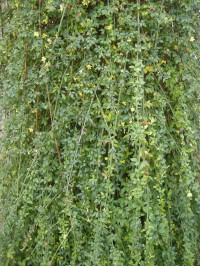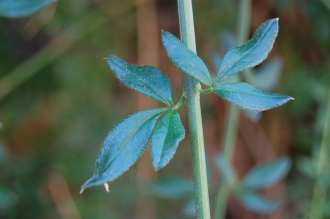Position: Full sun to partial shade
Flowering period: Late autumn to winter
Soil: Well drained
Eventual Height: 3m
Eventual Spread: 3m
Hardiness: 6a, 6b, 7a, 7b, 8a, 8b, 9a,9b
Family: Oleaceae
Jasminum nudiflorum is a deciduous non clinging climbing/ rambling shrub. It produces bright green four-angled arching stems. The glossy leaves are opposite, pinnate and dark green. The individual leaves are divided into three 3cm long oval leaflets. Solitary unscented yellow flowers are produced during the winter months, each having six petals and are 2cm across. These appear in the leaf axils. This plant may propagate itself by natural layering, where stems touch the ground.
Jasminum nudiflorum, commonly known as Winter Jasmine, is native to China. As the common name suggests this plant flowers during the winter months, from November to March. It was introduced into the UK in 1844. This plant, unlike other members of the family is not twining and will require tying in if grown vertically.
The etymological root of the binomial name of Jasminum is derived from Ysmyn, the Arabic for the genus. Nudiflorum is derived from the Latin nudi ‘naked’ and florum ‘flower’, referring to the fact this plant flowers on bare stems.
The landscape architect find Jasminum nudiflorum useful as a winter flowering wall trained shrub or a low growing scrambling plant.
Ecologically, Jasminum nudiflorum is attractive to insects.
Jasminum nudiflorum has won the prestigious Royal Horticultural Societies annual Award of Garden Merit in 1993.
Jasminum nudiflorum prefers fertile, well-drained soil, although it will tolerate poor soils. It will tolerate most pH of soil.
Jasminum nudiflorum requires little maintenance. This plant may be cut back hard in the spring immediately after flowering. Regular pruning will prevent bare patches on the plant







Leave a comment